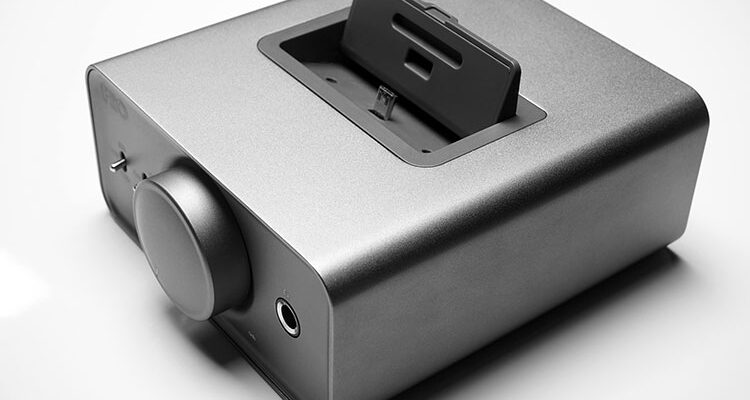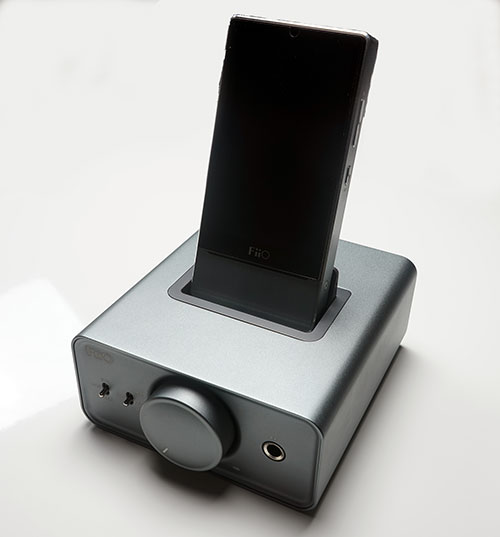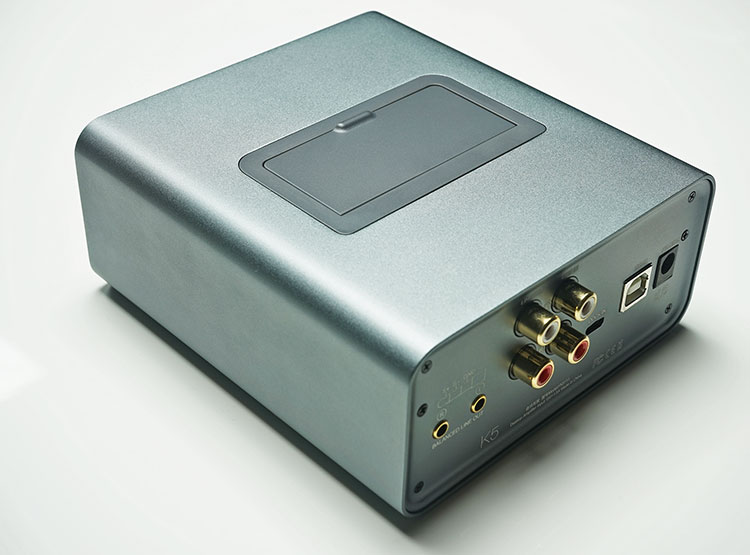The FiiO K5 is the company’s latest version of their all in one dockable DAC and integrated desktop amplifier for their X-range DAPs. It is priced at $110.
Disclaimer: The FiiO K5 sent to us is a sample in exchange for our honest opinion. We thank FiiO for this opportunity.
To learn more about FiiO reviews on Headfonics you can click here.
This one slipped down the publishing schedule, my bad, but it is rather good timing considering we just published the DK1 Multifunction dock a few weeks back which offers a slither of what the K5 can do with the X Series of DAPS and the E17k from FiiO. This time, instead of the DK1 $20 asking price for essentially a stand with a line out and charging, you get a $110 ticket price for a whole lot more.
Evolution
Those who have been following FiiO since the early days will recognize the K5 as a 3rd gen amp/pass through the DAC dock system that first started as the E9 in 2010. Back then the whole concept was to stick in your E7 DAC/Amp as the DAC component, turn it on, stick in the USB cable at the back of the E9 and bingo!
You have a mini DAC/Amp system capable of some decent power and a better signal than what the E7 was ever capable of. It looked very cool and for budding audiophiles on a budget, it was considered good value. The E9K, launched in mid-2012 was essentially a tweaked version of the original. In came an enhanced I/O array at the back, a better 3.5mm jack impedance output, and a more integrated power management facility to control both the E17.
The E9K, launched in mid-2012 was essentially a tweaked version of the original. In came with an enhanced rear plate I/O array, a single quarter jack output, and a more integrated power management facility to control both the E17 and the E9K at the same time. The basics were the same, the amp chips the same. For a device of its time, it was a perfect match for FiiO’s old portable DAC line.
What Is The Pitch?
The FiiO K5 makes a pitch now with the same docking principle of the old E9 series but this time thoroughly updated to match and support their current line of X-series DAPS with DAC functionality including the X3ii, X5ii, and the X7 (with amp module) as well as the E17K. It pretty much does everything that the DK1 does but throws in an amp stage, some gain options, and some dedicated RCA I/O at the back as well as a balanced line out.
The amp itself is considerably more powerful than anything the X Series DAPs and the E17K can produce, even with the AM5 module so this should be seen as a desktop amp and DAC solution aimed for those with desktop mid-fi or more power-hungry headphones that require a bit more juice. If you do not need the amp or do not need the juice, then the modules on their own or the DK1 will be better solutions.
Design
Much of the legacy of the E9 remains true in the new K5 despite its more modern lines and slight physical repositioning of its switches and dials. It is now a 30mm shorter, 35 mm wider and the same 55m in height. Much of that expansion in girth has to do with the large dock port bay on the top that is designed to hold the varying widths of the E17k/X3/5ii and the X7 as well as the additional switches on the front panel. The chassis is a little more rounded on the K5 and the quality of engineering has improved with the naked panel screws of the E9 now nonexistent on the integrated plating of the K5.
The Dock
The top panel is flush with only the dock port lid interrupting the smooth lines of the metal chassis. The docking port is a self-contained articulated lid and bay system with an interconnecting male micro USB socket for receiving and communicating with the X-series DAP of your choice once connected. The lid itself has a degree of swivel just like the DK1 so it can adapt and support the DAP correctly. The K5 also comes with a set of rubber tips that can be inserted into the back of the K5 dock lid. This helps support the differing sizes of the X-series DAPs and to prevent inadvertent scratches during use.
Front Panel
The front panel has a few changes also. The pot is still centered much like the old E9 and E9k but the wider front panel is now able to accommodate not only the old input switcher (line and dock on the K5) but also a new 3 level gain control system (low, medium and high) offering greater flexibility for today’s range of efficient and non-efficient headphones. This is compared to having only 2 gain options (high and low) at the back of the E9k. To all extents and
The volume range of the K5 is the same as the E9k starting at -90dB but this time the power-on LED in the lower-left corner has been upgraded to a backlit pot LED which looks all the more handsome and striking when turned on. It almost matches the same blue-lit panel of the X7 but just a touch more turquoise to it. The right side of the front panel is again finished with a quarter jack gold plated socket.
Back Panel
The back panel houses the majority of the inputs in terms of line in, USB in and proprietary dock in functionality as well as the AC power. It also houses the line out and a dual 3.5mm balanced output for those wishing to build a fully balanced system with another amp of differing specs.
Technically FiiO has actually slimmed down some areas from the old E09K back panel. Gone is the old aux and pre-out dual RCA and in its place is a dual RCA line and a dual RCA line out in unbalanced mode.
Functionality
The FiiO K5 actually has quite a wide range of useful applications for the asking price. Some of them do overlap with other complementary devices such as the DK1 however the K5 is the only such support device that offers built-in amplification for headphone use for the X Series. The various methods of connectivity and usage of the K5 are as follows:
- Standalone dock and amplifier combo using the X-series DAPs (X3ii/5ii/X7) as both DAC and storage for music files and connecting directly to your headphones
- USB out from your PC/MAC into the K5 using the X-Series DAP and E17K as your DAC and amplification directly to your headphones
- Line out from your existing DAC setup using the K5 dual RCA line in and K5 amplification direct to your headphones (could be 3.5mm single line out to dual RCA K5 line in also if using a DAP as your DAC)
- USB in (E17K) or docked X-series DAP with single-ended dual RCA line out to amp of your choice
- USB in (E17K) or docked X-series DAP with dual 3.5mm balanced output to XLR/3.5mm balanced headphone or stereo amp of your choice
- Secondary dock in (allowing points 1, 2, 4, 5 ) functionality for docking an X-Series DAP or E17K without using the top docking plate
- X-Series DAP and E17K charging while AC Power is on.
Amplification
The K5 uses a Texas Instruments TPA6120A2 powered amp stage which is a right old age now and came out around 2010. In actual fact, I guess FiiO quite love this amp stage because it is the same chip that can be found in the original E9 and the tweaked later 2nd Gen E09k.
It’s not clear to me if the K5 is still using an OPA2134 opamp alongside the TI buffer chip but given they didn’t change the buffer chip I presume they didn’t change the opamp either. The TI Buffer is generally known to be capable of producing high levels of power, with low distortions levels and more than capable of projecting a wide bandwidth. I guess if it’s not broken don’t fix it?
The important difference though between the older units and the K5 is the nominal output impedance is much more acceptable at less than 1 Ω compared to the almost 10 Ω rating of the original E9 which made it less appealing to those with low impedance headphones.
This time, the design is more attractive to those with efficient portable headphones and earphones who are looking for less play in their stock frequency response though the power rating might be a bit too much at 1.7W into 16Ω.
The original E9 amplification was also lauded for excellent low-level distortion performances with the TPA6120A2 and I expect no difference with the new K5 design, perhaps even better ratings.
Sound Impressions
Tonality
On its own, the K5 has a very similar tonality to the original E9 and E09k. It is inherently neutral with just a very tiny touch of warmth to keep the tonal presentation relatively smooth sounding rather than bone dry, overly warmed up or too bright. What you pump into the K5 and what you use to listen to it will be more of a factor in the tonal quality you get from the K5. That, in an amping world, is essentially a good thing.
What the K5 brings in over the standard amping sections of the E17K and the X-series DAPs (excluding the higher powered modules of the X7) is a much better handling of dynamics and an improved staging and imaging performance and a relatively black background when paired with headphones.
The K5 is simply much better at filling out and driving headphones than the X5ii and X3ii, and particularly the AM1 for the X7, which is not an ideal match at all for anything really other than IEMS.
The difference in amping though is less marked on IEM’s and to be frank, although the K5 handles the efficiency level very well, it is still overkill given the power output of the K5. Distortions levels are excellent with the K5 as-is noise control when paired with medium sensitivity headphones which is where its strength really is.
Matchability
IEMs
Noise
Despite the impressively high output power ratings from the K5 at 16 and 32 Ω it has to be said that it also has impressively low noise levels with efficient (read BA) IEMs. It is not an absolute zero, though, even on low gain some audio signal does slip in but background hiss is non-existent.
Volume
Volume control is not too bad with the Alps pot FiiO have used for the K5 with a tiny amount of channel imbalance on low gain. Using IEM’s with 110dB plus ratings up to 120dB increased volume came in slow from 10-20% then channel imbalance at 25% to the left channel and finally hitting the sweet spot around 25-30% (10pm on the volume dial) on low gain.
Gain
Interestingly there was only a marginal decrease from low to mid-gain in terms of volume with a net reduction of about 2-3% with efficient IEMs (VE6XC, VE5, Noble 4c) though highly efficient IEMs such as the Campfire Audio range were much lower and harder to get any sense of micro-adjustment on the volume control.
Background noise did become higher at the same volume level points on mid-gain with IEMs and the degree of volume wiggle room again dropped switching to high gain plus an even higher noise level. The only IEM(s) that bucked the trend were high Ω or high power-intensive IEMs such as the oBravo ERIB-5a but even then this was just an additional 10% (11pm on the dial) at low gain.
The K5 can do IEMs with a fair amount of noise control but very little micro-volume control even on low gain. Only in the most extreme cases would I use the K5 with an IEM such as the oBravo planar IEM. In all other scenarios, I would revert to the DAP itself for better control such as the FiiO X7 and your amp module of choice.
Headphones
This is where the K5 makes a whole lot more sense with its excellent power levels up to 32Ω off over 1 watt per channel and even giving decent but not earth-shattering levels of 300mW at 300 Ω. I wouldn’t really advise pairing 600 Ω cans to the K5, I just do not see the benefit with the power levels dramatically dropping beyond 300Ω.
For the majority of dynamic headphones sitting around 32 Ω, there is plenty of power on tap with the K5 driving with ease the likes of AIAIA’s TMA series, flagships such as the K812 (though tonally it is too treble sharp of a pairing), and the notoriously fickle K series headphones from AKG.
HE400S/Oppo PM-3
The K5 though has more than adequate power for efficient planar headphones. The Hifiman HE400s for instance really has no driving issues at all with the K5, sitting at 50% or noon on the volume pot on low gain, then a step lower at 11am on mid and around 10am (30%) on high gain.
Dynamics are excellent, the soundstage is enhanced considerably over the regular amp modules with excellent width and vocals are nicely focused. Very little coloration is added to the HE400S presentation. The same scenario for the Oppo PM-3 with a very easy to drive low gain at 11am, mid-gain at 10am and high gain at 9am.
Once again the K5 does very little in the way of coloration other than bringing in a full sounding and dynamic presentation.
LCD-2 v2/T50RP MK3
Audeze’s LCD-2 V2 (pre-fazor) does though require a much higher gain setting with it sounding a bit lean on low gain and pushing harder at around 2-3pm. Mid-gain drops the requirements down to around 50% volume with a touch more weight to the sound and high gain brings it right down to 11am but tonally it sounds a bit sharper than what I am used to on the LCD-2.
The mid-gain represents the best compromise for me tonally and power-wise. The same rang true for the Fostex T50RP, never the most efficient of planars on the market. This time high gain gave the best compromise between power, volume control, and tonal presentation.
The low gain option was simply not enough and mid-gain started hitting 1pm on the volume pot for the sweet spot which might not be ideal even if it gives a bit more wiggle in volume control than high gain.
Final Thoughts
The K5 at $110 is a good value and a well thought out device with a rich legacy going back a good 5-6 years, back when FiiO was known just for amps and DACs. It has been thoroughly modernized from the E9/09K though the core components in comes cases, like the opamp chip, remain the same.
Those who have tried the older E series docks will know what they are getting which is a powerful budget-fi desktop amplifier that will lift a lot of the amping load away from the weaker amp modules in the X-Series DAPs and the E17K. It will offer a superior option for driving headphones and in particular the newer range of efficient planars than the X3ii and X5ii on its own.
If you are rocking IEMs, you will not need the K5. It is impressive on low gain handling noise to the majority of IEMs I tested it with but the amping power does not add value. There are more capable and better performing IEM amps on the market that offer better detail and the X7 itself now has very capable modules such as the AM3.
Buy the DK1 dock instead if you need additional functionality such as charging which is a lot cheaper. If you are looking at headphones then the K5 becomes relevant and did a good job with cans such as the HE400S and the Oppo PM-3.
Technical Specifications
| General Specifications | |||
| Model/Number | K5 | Headphone Port | 6.35mm stereo Jack |
| Color | Titanium | Drive Ability | 16~300 Ω |
| Dimensions | 120mm× 130mm× 55mm | Volume Control | Via analog potentiometer (inc. power switch) |
| Weight | 450g | Gain | LOW: 0dB MID: 6dB HIGH:12dB |
| Partial Performance Parameters for Headphone Output | |||
| Output Power 1 | >1.7W(16Ω/THD+N<1%) | Output Impedance | <1 Ω |
| Output Power 2 | >1.5W(32Ω/THD+N<1%) | Crosstalk | >70 dB (1 kHz) |
| Output Power 3 | >150mW(300Ω/THD+N<1%) | THD+N | <0.002% (1 kHz 32Ω) |
| SNR | ≥110dB (A-weight) [AUX IN] | MAX Output Voltage | >20 Vp-p |
| Frequency Response | 10 Hz~90 kHz(-3dB,Input: 700mV) | MAX Output Current | 221.8mA |
| Partial Performance Parameters for Line Output | |||
| Line Output Level and TND+N | K5→X1:1.37V(THD+N:0.008%) K5→X3II:1.36V(THD+N:0.008%) K5→X5II:1.05V(THD+N:0.004% K5→X7:1.90V(THD+N:0.004%) K5→E17K:1.50V(THD+N:0.009%) |
0dB 1KHz,load:10KΩ | |
| Partial Performance Parameters for Balance Line Output | |||
| Line Output Level and TND+N | K5→X5II:1.05V(THD:0.004%) K5→X7:1.90V(THD:0.004%) |
0dB 1KHz,load:10KΩ | |
| Power and Battery | |||
| Power | DC 15V/1.5A | Battery Capacity | No battery |








